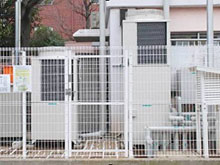Heat Island Mitigation Technology field (Heat pump air-conditioning systems using ground source heat, wastewater heat, etc.)
Heat Pump Air-Conditioning Systems Using Ground Source Heat, Wastewater Heat, etc.The technology involved is the utilization of the advantage of temperature difference between groundwater (ground source heat) and outdoor air. As groundwater has the characteristic of being warmer in winter and cooler in summer than outdoor air, an air-conditioning system using it as the heat source/sink can offer much more efficient cooling and warming performance than a system using outdoor air as the heat source/sink. One characteristic of this system’s operation in summer is that the waste heat from cooling is not discharged to the ambient air. The system contributes to the reduced discharge of artificial heat because of the following two reasons.
- In summer, as the system discharges waste heat into the ground, the discharge of waste heat to the ambient air is lower than the air-cooling heat pump which exchanges heat with the ambient air (the standard system at present) by means of discharging waste heat to the ambient air through an outdoor unit.
- As a heat pump air-conditioning system using ground source heat is much more efficient than the system using air source heat, discharge of waste heat to the ambient air can be reduced in proportion to the amount of energy saved in cooling and warming operations.
What is the heat island phenomenon?The heat island phenomenon means that the ambient temperature in the central area of a city becomes higher than that of its surrounding area. There are two main causes.
The first is an increased amount of artificial waste heat discharged from
the human use of air-conditioning systems, electrical appliances and automobiles.
The second is the increasing artificial coverage of the ground due to a decline
of vegetation and water bodies and increasing building areas and paved ground
surfaces.
Today, the heat island phenomenon has become widely known by the public as an
environmental problem specific to urban areas.
The MoE estimates that artificial heat accounts for approximately 50% of the
heat (sensible heat of the air) affecting the temperature increase of Tokyo’s
23 wards. Meanwhile, waste heat attributable to building functions, such as air-conditioning,
is estimated to account for half of the artificial waste heat.
The frequent occurrence of the heat island phenomenon and progression of global warming have been worsening the urban heat environment, making its improvement an urgent task. Here, it must be noted that artificial waste heat from offices and houses if the main factor for a temperature increase in large cities.
Reference: What is the Outline of Measures Against the Urban Heat Island EffectThe Outline of Measures Against the Urban Heat Island Effect which was drawn up in May, 2004 puts forward basic policies for the promotion of efforts by the central government, local governments, business operators and residents to mitigate the heat island effect in an appropriate manner and systematically compiles concrete measures for implementation. There are four main pillars for heat island effect mitigation measures: (1) reduction of artificial waste heat, (2) improvement of the state of ground coverage, (3) improvement of urban form and (4) improvement of lifestyle.The revision of the Outline in May, 2013 has added the new pillar (5) promotion of adaptation measures to reduce the impacts, etc.on human health.


















 Heat
Pump air-conditioning system using ground source heat
Heat
Pump air-conditioning system using ground source heat
